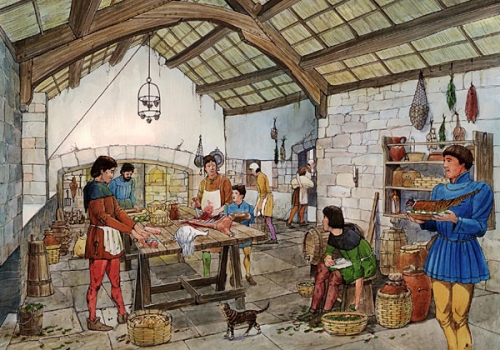The New Yorker counted Britain's Lawrence Norkolk among Europe’s best young novelists way back in '98, and yet he’s never quite made it across the pond. Not that he lacks for singularity — his first book, Lemprière’s Dictionary, concerns the writing of the Bibliotheca Classica, while The Pope’s Rhinoceros describes in encyclopedic detail the quest to bring a rhino from West Africa to the Pope. (One can only imagine what Sharon Olds would do with this title.)
Norfolk's Shakespearean vocabulary and voluminous range of historical references don’t make him an easy read, but with his newest book, John Saturnall’s Feast, he uses them in service of a far simpler story: the coming-of-age of an orphaned kitchen boy who, through his skill in cooking, slowly begins seducing the lord's daughter. Never before have I read a book so laden with food — archaic food, pungent food, weird food. To give you a bit of the book’s flavor profile, here are a few of the delicacies I ended up researching. (Vegetarians: run for your lives.)
Forcemeat
The first step in preparing sausages, pâtés, quenelles, and other meat-stuffed dishes. Raw meat is emulsified with fat by being ground or puréed together. Forcemeats can be made straight without additional ingredients, country-style with liver and other spices mixed in, gratin with some of the meat cooked before emulsification, or mousseline with cream and eggs for a lighter texture.
Madeira Sugar
Sugarcane had been growing on Madeira, just off of Portugal, and in the first half of the 17th century (when John Saturnall’s Feast takes place) no other major sources of sugar were available. Consequently, dishes that featured the “sweet salt” were rare. John Saturnall labors for days with it to create a transparent tart; he declares it is “for Tantalus” because of the jewels cooked inside, visible through the jelly.
Bukkenade
A stew of beef or veal usually including eggs and several spices, from hyssop to cloves and mace. “Sharpened” with verjuice (from sour fruits) or vinegar, the preparation makes a hearty concoction for the cold winter nights weathered in the manor. Even in John Saturnall’s time, however, the stew was considered “ancient,” and the best recipes online are written inMiddle English.
And that's not all. Norfolk has posted a glossary of even more obscure concoctions online. As I looked through the recipes that prefaced each chapter, it became increasingly clear that, even with the advances of modern technology and global cuisine, cooking nowadays is hardly as downright strange as it was in John Saturnall’s time. We owe Norfolk our thanks for keeping it alive.
And now, if you'll exuse me, I must check on my chawdron: "A black sauce made with boiled giblets and offal (especially liver) and often served with roasted swan."
Kitchen image credit: skiptoncastle.co.uk; Forcemeat image credit: kitchenmusings.com; Sugarcane image credit: madeirahelp.com; Bukkenade image credit: medievalcookery.com








 A Black Balloon Publication ©
A Black Balloon Publication ©